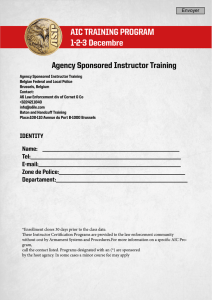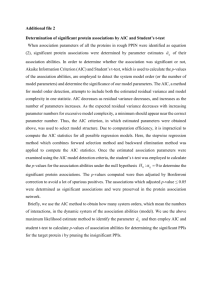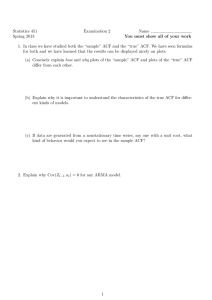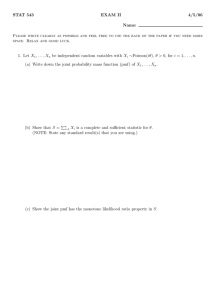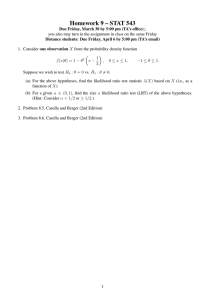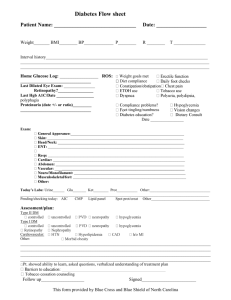Model Selection and Comparison Advanced Biostatistics Dean C. Adams
advertisement
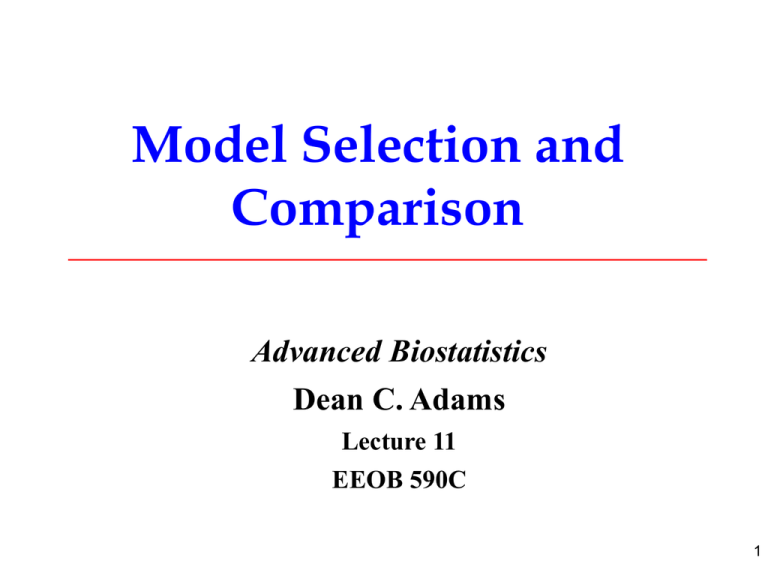
Model Selection and Comparison Advanced Biostatistics Dean C. Adams Lecture 11 EEOB 590C 1 Today • Why compare alternative models? • Model comparison with likelihood ratio tests (nested models) • Model selection with information theory (nested or nonnested models) • Cross-validation procedures • Prerequisites, limitations, advantages, and disadvantages. For further information on these approaches see: Burnham and Anderson (2002) Model selection and inference. Bedrick and Tsai (1994) Model selection for multivariate regression in small samples. Biometrics 50:226-231. 2 Why Model Selection/Comparison? • Often, (especially in observational studies) it is unknown what ‘explanatory’ variables are important sources of variation in some measured response(s). • We can always ‘dump’ any or all explanatory variables into a model, but there are some problems with this. • Consider the following plot: R 1 1 R n 1 * a = ‘adjusted’ 2 a % Variation explained R2 Ra2 2 n k 1 Increasing model parameters (k) results in: 1) Reduction of explained information relative to the model “size” 2) Potential loss of statistical power (i.e., eventually model df > error df) Model parameters (k) 3 Why Model Selection/Comparison? • The goal with model selection/comparison approaches is to evaluate two or more models with different sets of parameters to determine if one is ‘better’ (i.e., explains more variation in the response given certain criteria). Likelihood ratio tests (Statistical comparison of nested models) Information Theoretic Indices (Ranks models using parsimony principle) Cross Validation (Measures robustness of a particular model) 4 Likelihood Ratio Tests • Although not explicitly stated, we have performed many likelihood ratio tests thus far. • Likelihood ratio tests involve statistically comparing one model (e.g., full model) with an alternative model that is nested within the full model (e.g., reduced model). • E.g., MANOVA with Wilks’ Λ Let T be the p x p SSCP matrix for the data that can be partitioned into H (the SSCP matrix for predicted values) and E (the SSCP matrix for residuals). For nested models, T = HFull + EFull = HReduced + EReduced A difference in models is thus ∆H = HFull - HReduced = EReduced - EFull In MANOVA, we can use Wilks’ Λ to determine if an effect is significant. This effect is removed from the reduced model. Thus, the difference in response variation explained between full and reduced models is the variation due to the effect. 5 Likelihood Ratio Tests Let T be the p x p SSCP matrix for the data that can be partitioned into H (the SSCP matrix for predicted values) and E (the SSCP matrix for residuals). For nested models, T = HFull + EFull = HReduced + EReduced A difference in models is thus Wilks Λ ∆H = HFull - HReduced = EReduced - EFull But how is this information useful? E Full E Full H Typical definition E Full E Full E Re duced E Full E Full E Re duced Alternative definition involves a ratio of model error determinants * Wilks Λ can be converted to a statistic that approximately follows an F-distribution. 6 Likelihood Ratio Tests • Defining model likelihood (using multivariate normal distribution) L (βˆ | Y ) Model likelihood: the likelihood of model parameters (β), given the data (Y) • For normally distributed error (either uni- or multi-variate), the maximum likelihood estimator (MLE) is: L(βˆ | Y) 1 2 np Σ n/2 e Yi -Y Σ1 Yi -Y t 2 n Y μ Σ1 Y μ t 2 The right side of the equation is the multivariate normal probability density function (Σ is the error covariance matrix), and is maximized when Y = μ (i.e., the exponent is 0) • The previous equation can be rewritten (with exp = 0) as: 1 n n This latter part is a constant* log L(βˆ ) n log Σ log 2 2 2 2 1 • Thus log L(βˆ ) n log Σ is the log-likelihood of a linear model! 2 *ONLY the case for comparing nested models for the same data. For general likelihood of model, use full equation 7 Likelihood Ratio Tests • Consider the following: 1 1 log L(βˆ full ) log L(βˆ reduced ) n log Σ full n log Σ reduced 2 2 1 n log Σ full log Σ reduced 2 •Therefore, Σ full L(βˆ full ) 1 log n log L(βˆ reduced ) Σreduced 2 is a likelihood ratio test (LRT)* * Note: it is common convention to multiply both sides by -2 and express the LRT as Σ full LRT 2 log L( reduced ) log ( L( full ) n log Σreduced which approximately follows a Chi-square distribution with (Δk)p df, where p is the number of response variables and ki is the number of model parameters for the ith model. 8 Likelihood Ratio Tests • Recall, E Full ERe duced •And, because Σ = |E|/np, •It should be obvious that E Full ERe duced E Full n p Σ full ERe duced Σ reduced p n •Thus, Wilks Λ is an LRT! The null hypothesis of an LRT is that the additional parameters in the full model offer no improvement over the simpler set of parameters in the reduced model. A significant LRT (rejection of the null hypothesis) implies that significantly more variation was described by the additional parameters of the full model. Therefore, the full model is considered a significant improvement over the reduced model. 9 Likelihood Ratio Tests: Example •Head shape of (live!) prairie rattlesnakes (Smith and Colly, 2008) •Compared several biological hypotheses explaining morphological variation Smith and Collyer, 2008. In The biology of rattlesnakes. 10 Likelihood Ratio Tests: Example • Models considered: Nested Within Previous FULL: Shape = Sex + Region + Sex × Reg. + SVL Sex-reduced: Shape = Region + SVL (Note Different than MANOVA because Sex × Reg. is not included) Region-reduced: Shape = SVL SVL-reduced: Shape = Region • LRTs: • Full vs. Sex-reduced = Test of sexual dimorphism • Sex-reduced vs. Region-reduced = Test of regional variation • Sex-Reduced vs SVL-reduce = Test of shape/size variation Smith and Collyer, 2008. In The biology of rattlesnakes. 11 Likelihood Ratio Tests: Example • Results Full Model for LRT Sex + Region +Sex × Region + SVL Reduced by: Sex + Sex × Region Region + SVL Wilks’ Λ = 0.597, P = 0.29 Region Wilks’ Λ = 0.654, P = 0.00029 SVL Wilks’ Λ = 0.517, P = 0.00031 •Conclusions: • Sex is not an important source of head shape variation but Region and SVL are certainly important. • When a MANCOVA was performed, sexual dimorphism was significant, but in this case, the Sex × Region term remains in the reduced model. • LRTs demonstrate that adding parameters for Sex and Sex × Region does not offer a significant improvement over a simpler model! Smith and Collyer, 2008. In The biology of rattlesnakes. 12 Likelihood Ratio Tests: Example 2-d Plane containing the three regional head shapes (East, West, Central) in the p = 15 multivariate shape space Hibernacula = sandy mammal burrows (large holes) Hibernacula = rocky buttes (small, narrow holes) Hence, regional variation shows an important biological signal. If sexual dimorphism was tested in the classical sense (e.g., MANOVA), one might conclude it was meaningful. However, it is less meaningful than locally adapted head shape divergence. Smith and Collyer, 2008. In The biology of rattlesnakes. 13 Likelihood Ratio Tests • Advantages • Provides a statistical assessment of model difference, based on importance of parameters that differ between models – ELEGANT! • Can be performed on any level of hierarchical structure (e.g., a model with parameters A, B, C, D, E, F can be compared to one with parameters A and E, one with just F, or one with B, C, and D in the same manner) • Disadvantages/Limitations • As long as n:kp ratio is large, significant differences between models are likely, even for small effects • Common misconception: Models must be nested comparisons Σ full L(βˆ full ) 1 log n log ˆ L(β reduced ) Σreduced 2 Really? What about this equation implies that models must be nested? 14 Likelihood Ratio Tests: Non-Nested Models • LRT straightforward with nested models: LRT statistic follows c2 LB Q 2 log LA •Non-nested models: •Procedure LB Q 2log 1: Obtain -Q is always positive, as A is nested in B -A is the ‘null’ and Q evaluated the improved fit of B vs. A -Q not is always positive - Not clear which model is the ‘null’ LA 2: Simulate data under A, and generate distribution of Qrand 3: Compare Qobs to distribution of Qrand 4: Simulate data under B and repeat process Possible outcomes: Q significant when A null, but not when B null: (B is preferred) Q significant when B null, but not when A null: (A is preferred) Q significant when both are null (neither model preferred) Q not significant when both are null (no discrimination between models) Lewis et al. 2011. Methods Ecol. Evol. Qobs 15 Information Theoretic Model Selection •Approach that ranks candidate models based on score: typically AIC (Akaike’s information criterion)* •Model selected that explains the most information with the fewest parameters (a ‘parsimony’ criterion) •Not based on significance testing! •A ‘best’ model found when difference between models is AIC > 4 Note: why AIC > 4 ? Because for 1df, c2 = 3.814 ~ 4 (from frequentist stats!) *Note: not really ‘information theoretic’ in the computational sense. That work is based on entropy of information, used in signal processing (and interestingly compression algorithms), and is based on Shannon (1948). 16 Information Theoretic Model Selection • Principle of Parsimony This illustration is hypothetical: to measure sampling bias and variance of parameters, true population parameters would need to be known. under-fit over-fit Bias Variance (in k) parsimonious few Number of parameters (k) many 17 Information Theoretic Model Selection • Principle of Parsimony • In general, the goal is to explain the most information possible with the fewest parameters needed. • Akaike (1973, 1974) developed an “information criterion” for penalizing model likelihoods as a function of the number of model parameters. Now called Akaike’s information criterion (AIC). • The most general form of AIC is (Bedrick and Tsai 1994): ˆ ) 2 pk 0.5 p( p 1) AIC 2 log L(β • However, because most use AIC with univariate response data only, it is generally simplified to ˆ AIC 2 log L(β) 2 k 1 18 Information Theoretic Model Selection ˆ ) 2 pk 0.5 p( p 1) AIC 2 log L(β Dimensions of Σ matrix Model likelihood part (larger model likelihoods are more negative) (increasing the number of response variables geometrically increases the number of covariances among the variables) Dimensions of β matrix (larger number means more parameters in model) 2 times the sum of these is the “parameter penalty” for the model likelihood (remember that variable covariances appear twice in a covariance matrix, hence the multiplication by 2) •So, small values of AIC imply a better model than large values, because less error in model, hence lower AIC 19 Information Theoretic Model Selection • Note: the parameter penalty is arbitrary •AICc (second order AIC): n AIC c 2 log L(βˆ ) 2 K * n K 1 where K is the bracketed portion of the parameter penalty of AIC (this is severely crippling for multivariate data, but is considered a “sample size correction” when n is low for univariate data). • QAIC (quasi-likelihood AIC): Q AIC 2 log L(βˆ ) cˆ 2K where c is a dispersion index equal to χ2/df (i.e., corrects for over-dispersion) • BIC: (Bayesian AIC): B IC 2 log L(βˆ ) 2 K log n • Plus many others (see Burnham and Anderson 2002) 20 ITMS Example • Candidate models: Model Sex Region Sex*Reg SVL Full X X X X MANCOVA X X X X I X X II X X III X IV X X V X X VI X VII Sex*SVL X Reg* SVL X X X X Sex*Reg* SVL X AIC Δ AIC* -13285.574 90.46583 -13341.302 34.73799 -13338.149 37.89086 -13355.83 20.20989 -13336.489 39.55036 -13358.317 17.72253 -13376.04 0 -13360.637 15.40285 -13365.501 10.5392 * ΔAICi = AICi – min(AIC). The highlighted models are those with low AIC values and warrant further inspection. Burnham and Anderson (2002) offer a scale (ΔAICi >2) for judging ΔAICi values but this should be avoided! In this example, LRTs were performed on the 4 highlighted models and model V was significantly better than the two simpler models and the one more complex model. Smith and Collyer, 2008. In The biology of rattlesnakes. 21 Nested Models: LRT or ITMS? • In the previous example, models were nested and LRT and ITMS gave the same results. • Burnham and Anderson (2002) believe that ITMS should be performed in place of LRT, indicating that no change in AIC accompanied with a k = 8 change in model parameters results in a significant LRT (i.e., the additional 8 parameters caused a significant difference between full and reduced models). • This logic, however, is flawed because AIC contains model likelihood; thus no change in AIC would require a linear -1:1 change between model likelihood and the parameter penalty described by additional parameters – this is impossible! • With nested models, AIC offers no advantage over LRT for the following reason (using multivariate normal definition of model likelihood): E ERe duced AIC n log Full p 2 p ( k ) 0.5 p ( p 1) n log p 2 p ( k ) 0.5 p ( p 1) Full Re duced p np n E E Re duced AIC n log Full log 2 p ( k Full kRe duced ) p np n E Full AIC n log 2 pk E Re duced AIC n log 2 pk Thus, the difference in AIC values for two models is the LRT plus a parameter penalty! 22 Non-nested Models: ITMS Example • Non-nested models for pupfish data Size = Centroid size (CS), the square root of summed squared distances from landmarks to centroid CS Total CS separately for head (H), body (B), and tail (T) 23 Non-nested Models: ITMS Example Models of body shape variation: 1) Population differences only 2) Population differences and shape allometry (using overall body size) 3) Population differences and regional shape allometries (using separate measures of H, B, and T size) * Models 2 and 3 are not nested Models Wilks Λ df Model df Error P Δ AIC 1 Population 0.0263389 154 1,177.166 <0.0001 2,412.292 2 Pop. + CSTotal 0.0053559 176 1,321.522 <0.0001 2,220.942 3 Pop. + CSH + CSB + CST 0.0000001 220 1,586.936 <0.0001 0 Conclusion: A model with regional allometries explains much more shape variation despite the additional parameters needed for this model! In this example, a clear difference among models was observed. This is not always the case. Using ITMS is tricky when there is model uncertainty. 24 Non-nested Models: Model Uncertainty • In the previous example, it was obvious using ITMS which model was best. THIS IS NOT ALWAYS THE CASE! • Consider this example Model (defined by parameter sets) A A+B C ΔAIC 3 0 2 •The ‘close’ models (ΔAICi near 2) are considerd candidate models. Model weights for the ith model is defined as wi exp 0.5(AICi ) C exp 0.5(AIC ) Such that w1 + w2 + … + wC = 1 (w is called Akaike weight) i i 1 • Model weight is sort of like the probability of model i given the set of C candidate models • Thus Model A A+B C ΔAIC 3 0 2 wi 0.122 0.547 0.331 Model Averaging: β*= 0.122 βA + 0.547 βA+B + 0.331 βC Note that parameters in A have more weight because they appear in two different models 25 Non-nested Models: Model Uncertainty • Model averaging is a VERY DANGEROUS thing to do! •1: arbitrary inclusion of models that shouldn’t always be included •Consider the following example: Models F df Model df Error P Δ AIC 1 Region + SVL 5.537 3 103 0.0014 1413.114 2 Region + SVL + Region *SVL 3.826 5 101 0.00324 1414.552 •From typical recommendation (ΔAICi < 2), models should be averaged. •BUT, LRT of 1 vs. 2 NOT significant (F=1.228; df=2; P = 0.2984) •Thus, interaction should not in included •Also, AIC of averaged model is WORSE! AIC= 1415.718 •Model averaging NOT appropriate here (and probably elsewhere) 26 Non-nested Models: Model Uncertainty • Model averaging is a VERY DANGEROUS thing to do! • 2: Assumes that the weights are appropriate. Akaike weights seem intuitive, especially for univariate data. • However, what should be the distribution of weights under a null hypothesis? In other words, if you take random data and add parameters to a model, what should the distribution of weights for each model look like? • One would expect that by chance adding parameters to the model offers an improvement in rare cases, but the expected value is probably close to Δk = 0. (i.e., like a Poisson process) wi 0 1 2 3 4 5 Δk •Random variable in all models receives weight of 1.0, yet, is not explaining variation in Y! 27 Non-nested Models: Model Uncertainty • 3: Multivariate data: Consider what happens when parameters are added to a model with no increase in likelihood (i.e., random data or a fully-saturated model) Δk p= 1 2 3 4 5 6 7 8 0 2 6 12 20 30 42 56 72 1 4 10 18 28 40 54 70 88 2 6 14 24 36 50 66 84 104 3 8 18 30 44 60 78 98 120 4 10 22 36 52 70 90 112 136 5 12 26 42 60 80 102 126 152 6 14 30 48 68 90 114 140 168 7 16 34 54 76 100 126 154 184 8 18 38 60 84 110 138 168 200 p= Weight distributions Δk Parameter penalty with no change in model likelihood Akaike’s weights are practically binary with p > 4 1 2 3 4 5 6 7 8 0 0.632199 0.864665 0.950213 0.981684 0.993262 0.997521 0.999088 0.999665 1 0.111476 0.006686 0.000123 0.000001 0.000000 0.000000 0.000000 0.000000 2 0.023951 0.000456 0.000003 0.000000 0.000000 0.000000 0.000000 0.000000 3 0.006950 0.000052 0.000000 0.000000 0.000000 0.000000 0.000000 0.000000 4 0.002014 0.000006 0.000000 0.000000 0.000000 0.000000 0.000000 0.000000 5 0.000578 0.000001 0.000000 0.000000 0.000000 0.000000 0.000000 0.000000 6 0.000173 0.000000 0.000000 0.000000 0.000000 0.000000 0.000000 0.000000 7 0.000054 0.000000 0.000000 0.000000 0.000000 0.000000 0.000000 0.000000 8 0.000017 0.000000 0.000000 0.000000 0.000000 0.000000 0.000000 0.000000 Information Theoretic Model Selection • Advantages • Can consider non-nested models • Penalizes model likelihood by the number of parameters needed in the model (for similar likelihoods, simpler models are better than complex ones) • Limitations • Choice of parameter penalty is arbitrary. Although there are sound statistical reasons to choose one type of information criterion (IC) over another, there are no statistical distributions for ICs, and ICs do not incorporate biological reasoning. • ITMS Indices are univariate even if data are multivariate. ICs only measure magnitude of deviation of models, but not direction in the parameter space. • Disadvantages • Not really a statistical test, and proponents of ITMS have argued strongly that statistical tests are useless. However, the statistical theory of LRT is wellfounded and does not necessarily differ from ITMS for nested models • Model averaging – proceed with caution. Model averaging not fully developed using ITMS indices. 29 Model Evaluation: Cross-validation • One problem with any model selection process is that the goal is to select the best model from a set of candidate models. But what if all the models are garbage? • Cross-validation is a method of evaluating the robustness of a particular model. It is related to model selection in that the model that is most robust (from a set of candidates) may be considered the best. • Cross-validation involves breaking data into two groups, estimating parameters in one group, using those parameters to predict values in the second group, and then measure the error. •A robust model is one where error is minimized. 30 Model Evaluation: Cross-validation Example 9 8 Two models: 7 Y 6 1) y = mean 5 4 2) y = bo +b1x 3 2 1 0 0 2 4 6 8 10 12 X Results Step 1: Randomly choose 5 values and estimate parameters for both models Step 2: Use these parameters to estimate the value for the other 5 (for both models) Step 3: Calculate the residuals for the remaining 5 values (for both models) Mean model Regression model Mean (SS) Var (SS) CI+- 36.16 180.38 18.8 68.4 3.85 11.63 0.935 10.5 Regression model obviously more robust Step 4: Describe the cross-validation criterion as the sum of squared residuals (SS) Repeat 1000 times 31 Model Selection/Comparison Final Comments • Model selection is a good idea when it is not clear what potential sources of variation exist (i.e., maybe not needed for an experimental study where treatments are controlled). • Model selection might put you in the right ballpark, but it does not make inferences for you. • Never should one abandon, e.g., biological reasoning, and trust the outcome of naïve model selection (i.e., if you know that a certain parameter needs to be in the model – perhaps organism size – then neither choose a candidate model that lacks this parameter, nor trust an index ranking that excludes it as important). • Model selection is a tool in a large toolbox of statistical and analytical procedures. It is a tool that should probably be used early, followed by more rigorous methods. It SHOULD NOT be the focus of the data analysis. 32 Model Selection/Comparison Final Comments • Although this lecture dealt with regression/ANOVA type linear models, model selection is quite prevalent in other disciplines. • A major use of model selection is in phylogenetics. • Model selection can be used to help infer the “best” phylogenetic relationship of taxa: • LRT can be used to compare simpler trees to full trees. • ITMS can be used to compare trees with different models of evolutionary rates. • Cross-validation can be used, removing taxa and estimating trees at each iteration, to evaluate tree-robustness. • ITMS is also quite popular for Mark/Recapture and population growth studies (see Burnham and Anderson 2002). 33
